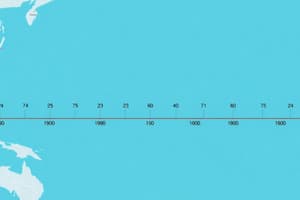Podcast
Questions and Answers
When crossing the International Date Line (IDL) from East to West, what change does a person have to make?
When crossing the International Date Line (IDL) from East to West, what change does a person have to make?
- No change needed
- Add one day (correct)
- Subtract one day
- Adjust the time by 12 hours
If it is Wednesday 10 a.m. at 15⁰ E meridian, what will be the time at the International Date Line (IDL)?
If it is Wednesday 10 a.m. at 15⁰ E meridian, what will be the time at the International Date Line (IDL)?
- Wednesday 9 p.m. (correct)
- Wednesday 6 a.m.
- Thursday 2 p.m.
- Thursday 6 p.m.
According to the international convention, at which meridian does the day and date change occur?
According to the international convention, at which meridian does the day and date change occur?
- 45° W Meridian
- 180° Meridian (correct)
- 90° E Meridian
- 150° E Meridian
Why is the International Date Line (IDL) not a straight line like the 180° meridian?
Why is the International Date Line (IDL) not a straight line like the 180° meridian?
Flashcards
Why is the International Date Line not a straight line?
Why is the International Date Line not a straight line?
The International Date Line exists to ensure the date changes at a specific geographic point. While the 180th meridian is the base, the IDL deviates to accommodate geographical features, such as islands or archipelagos.
What happens when you cross the Date Line going West?
What happens when you cross the Date Line going West?
When traveling westward across the International Date Line, the date advances by one day.
What meridian is used to mark the change in date?
What meridian is used to mark the change in date?
The 180th meridian serves as the base for the International Date Line, although the line itself deviates from it for geographical reasons.
What time is it at the IDL when it's 10:00 AM on Wednesday at 15 degrees East?
What time is it at the IDL when it's 10:00 AM on Wednesday at 15 degrees East?
Signup and view all the flashcards
Study Notes
Crossing the International Date Line
- When traveling from East to West across the International Date Line (IDL), a person must subtract a day from their calendar date.
- The IDL is not a physical line, but rather an imaginary line on the Earth's surface that separates two consecutive calendar days.
Time Calculation
- If it is Wednesday 10 a.m. at 15⁰ E meridian, it would be Tuesday 22:00 (10 p.m.) at the International Date Line (IDL), since the IDL is 15 hours behind the 15⁰ E meridian.
International Convention
- According to the international convention, the day and date change occurs at the 180° meridian, which is the location of the International Date Line (IDL).
IDL Not a Straight Line
- The International Date Line (IDL) is not a straight line like the 180° meridian because it deviates from the 180° meridian to avoid dividing certain island groups and territories into two separate days.
Studying That Suits You
Use AI to generate personalized quizzes and flashcards to suit your learning preferences.




